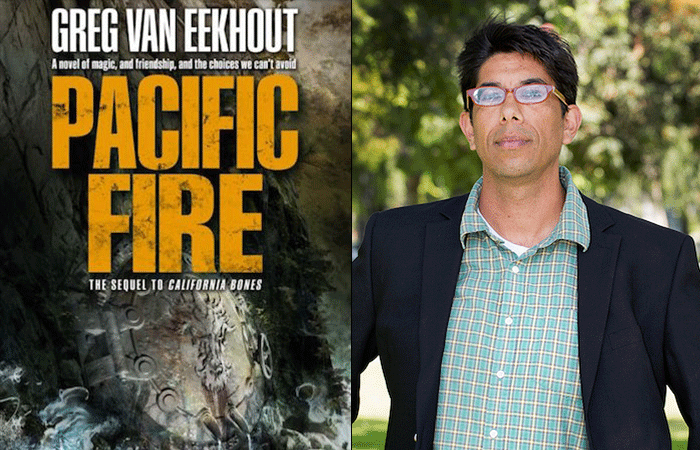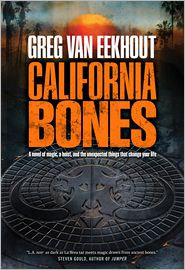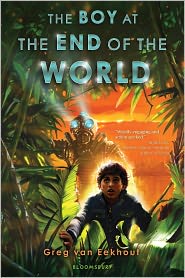Heists, Ancient Dragons, and L.A. Noir: Greg Van Eekhout on His New Book, Pacific Fire
 Greg Van Eekhout’s California Bones was one of the sleeper surprises of 2014, an urban fantasy with an irresistible magical hook (“osteomancers” gain power by eating the bones of ancient magical creatures…and sometimes each other) and a plot built on the addictive structure of the team heist (if you can stop watching Ocean’s Eleven when you flick past it on TV, you have much more willpower than I do).
Greg Van Eekhout’s California Bones was one of the sleeper surprises of 2014, an urban fantasy with an irresistible magical hook (“osteomancers” gain power by eating the bones of ancient magical creatures…and sometimes each other) and a plot built on the addictive structure of the team heist (if you can stop watching Ocean’s Eleven when you flick past it on TV, you have much more willpower than I do).
Pacific Fire
Pacific Fire
Hardcover $24.99
This week, Eekhout is back with the sequel, Pacific Fire, which ups the stakes in every way, as magician-in-hiding Daniel Blackland must stop running and reunite his old team as he attempts to rescue his adopted son from a madman’s plot to resurrect an eons-old for-real-wings-and-everything dragon. He took some time out to answer our questions about L.A. noir, avoid getting preachy with your plot lines, and the strange logic of ingesting ancient magic.
California Bones is the kind of book I love, one that manages to take a bunch of things everyone is familiar with (heist stories, gritty LA noir) and transform them into something that feels entirely of itself. What sparked the creation of this world?
I grew up in Los Angeles, and I was always fascinated by the La Brea Tar Pits. Right in the middle of the city, in an area called the Miracle Mile, for crying out loud, we have these eldritch ponds of dark, bubbling goo. And down in the muck there’re all these amazing fossils: mammoth and saber tooth cat and dire wolf. So, how could there not be a story there? The leap from what’s actually there to what could be there — like the remains of dragons and griffins and such — was not a very far jump. The idea that you could eat the remains of a dragon and get some of the abilities of a dragon was also kind of obvious. The story grew up around that idea, and the world grew up around the story.
Heist films and seedy L.A. pictures like L.A. Confidential and Chinatown seem like obvious touch points (especially since scarcity of water in the city is a major plot point). Did you try to tiptoe around these familiar plot elements, or do you see them as hooks to grab readers?
I was definitely influenced by those films, plus a lot of books and short stories. There’s a rich tradition of Los Angeles fantasy. But Los Angeles does have a real history of police corruption, and it does have a history of nefarious water deals. I tried to riff off the actual history of Los Angeles rather than other books and films that deal with the same material.
Did your editor/publisher ever have any qualms about making Walt Disney a sinister dark wizard?
I might have been the one with more qualms. I am trouble averse!
This week, Eekhout is back with the sequel, Pacific Fire, which ups the stakes in every way, as magician-in-hiding Daniel Blackland must stop running and reunite his old team as he attempts to rescue his adopted son from a madman’s plot to resurrect an eons-old for-real-wings-and-everything dragon. He took some time out to answer our questions about L.A. noir, avoid getting preachy with your plot lines, and the strange logic of ingesting ancient magic.
California Bones is the kind of book I love, one that manages to take a bunch of things everyone is familiar with (heist stories, gritty LA noir) and transform them into something that feels entirely of itself. What sparked the creation of this world?
I grew up in Los Angeles, and I was always fascinated by the La Brea Tar Pits. Right in the middle of the city, in an area called the Miracle Mile, for crying out loud, we have these eldritch ponds of dark, bubbling goo. And down in the muck there’re all these amazing fossils: mammoth and saber tooth cat and dire wolf. So, how could there not be a story there? The leap from what’s actually there to what could be there — like the remains of dragons and griffins and such — was not a very far jump. The idea that you could eat the remains of a dragon and get some of the abilities of a dragon was also kind of obvious. The story grew up around that idea, and the world grew up around the story.
Heist films and seedy L.A. pictures like L.A. Confidential and Chinatown seem like obvious touch points (especially since scarcity of water in the city is a major plot point). Did you try to tiptoe around these familiar plot elements, or do you see them as hooks to grab readers?
I was definitely influenced by those films, plus a lot of books and short stories. There’s a rich tradition of Los Angeles fantasy. But Los Angeles does have a real history of police corruption, and it does have a history of nefarious water deals. I tried to riff off the actual history of Los Angeles rather than other books and films that deal with the same material.
Did your editor/publisher ever have any qualms about making Walt Disney a sinister dark wizard?
I might have been the one with more qualms. I am trouble averse!
California Bones
California Bones
In Stock Online
Paperback $17.99
Your magic system is gruesome and visceral, but also oddly logical. How did you come up with it?
I don’t think that eating bones is necessarily gruesome unless you’re a vegetarian. [Ed. note: That explains it…] And I try to eat vegetarian, though I’m not very good at it and it’s a work in progress. But we basically are what we eat. Eat fat, and there’s fat in your body. Eat protein, and there’s protein in your body. Eat magic, and there’s magic in your body. The gruesome part comes in when people start getting more magic by eating other people who’ve eaten magic. I can’t even remember how I came up with that idea. It just seemed kind of obvious that it would work that way. I guess I’m gruesome!
One of my favorite bits is the way you’ll offhandedly mention the bones of creatures like griffins and dragons as having really existed in this version of history. How much have you developed the ecology of this world? Did dinosaurs exist, and more importantly, when is someone going to ingest a T-Rex skull and go to town?
There’s a certain amount of world-building that I hold off on until I need it for the story. World building in advance isn’t really my thing, maybe because I didn’t grow up playing RPG’s. So there’s actually a lot of stuff I don’t know about the world yet because my characters have no reason to know it. Were there dinosaurs? I imagine so, but do their remains possess magical qualities? My gut tells me no, but I can’t know that for sure until I have a reason for a character to know that. In the third book of the trilogy, Dragon Coast, I skip right past dinosaurs and go for bones from the dragon that lived at the center of the earth. Maybe that’s what really wiped out the dinosaurs.
Your magic system is gruesome and visceral, but also oddly logical. How did you come up with it?
I don’t think that eating bones is necessarily gruesome unless you’re a vegetarian. [Ed. note: That explains it…] And I try to eat vegetarian, though I’m not very good at it and it’s a work in progress. But we basically are what we eat. Eat fat, and there’s fat in your body. Eat protein, and there’s protein in your body. Eat magic, and there’s magic in your body. The gruesome part comes in when people start getting more magic by eating other people who’ve eaten magic. I can’t even remember how I came up with that idea. It just seemed kind of obvious that it would work that way. I guess I’m gruesome!
One of my favorite bits is the way you’ll offhandedly mention the bones of creatures like griffins and dragons as having really existed in this version of history. How much have you developed the ecology of this world? Did dinosaurs exist, and more importantly, when is someone going to ingest a T-Rex skull and go to town?
There’s a certain amount of world-building that I hold off on until I need it for the story. World building in advance isn’t really my thing, maybe because I didn’t grow up playing RPG’s. So there’s actually a lot of stuff I don’t know about the world yet because my characters have no reason to know it. Were there dinosaurs? I imagine so, but do their remains possess magical qualities? My gut tells me no, but I can’t know that for sure until I have a reason for a character to know that. In the third book of the trilogy, Dragon Coast, I skip right past dinosaurs and go for bones from the dragon that lived at the center of the earth. Maybe that’s what really wiped out the dinosaurs.
The Boy at the End of the World
The Boy at the End of the World
Paperback $8.99
There’s the potential to read your books as an environmental allegory about our dwindling natural resources—particularly oil, the magic that runs our world. How do you go about layering these kinds of themes into your work? Is it intentional, or a natural outgrowth of the story you’re telling?
I’d say it’s a natural outgrowth because I’m not a preachy writer, but one of my middle-grade books, The Boy at the End of the World, has all sorts of points to make about the consequences of how we use the environment, so maybe the points I make in the California Bones books are a wee bit intentional. But I think it’d be weird to write about scarce resources like magic and not have there be a connection to scarcity of natural resources in real life. So maybe it’s unavoidable.
Did you always envision this story as a trilogy? Book one could easily stand alone, and the world is rich enough that the story could also extend far beyond just three books.
Originally it was just a short story, “The Osteomancer’s Son,” which was in Asimov’s Science Fiction. A lot of readers told me they wanted more of that world and those characters. And when book editors started telling me that before I’d ever written a novel, I figured I’d be trying to tackle it as a book before too long. I pitched it as a two-book sequence, but when my editor at Tor Books made an offer for a trilogy, I bit. I have other stories I could tell in the world and other characters I’d like to write about, and characters from the trilogy I’m not quite done with yet. If readers respond to the first three books, maybe there’ll be more.
California Bones was your first major novel for adults, after a few books for the middle grade crowd. How does your process differ based on what audience you are writing for?
The books aren’t the same, but the process is the same. You put yourself in the mind of the character and experience the world through their senses and thoughts. To me, that’s the essential task of any storyteller.
Book two shifts the action from the team-based heist to more of a covert action/suspense thriller. Is it important for you to shake things up from book to book?
Definitely. Otherwise you end of exploding a second Death Star and you try to cover up the repetitiveness with Ewok distractions. And I never cared about that turtle guy who flies with Lando the way I cared about Chewie.
What’s your elevator pitch for the series?
IN A WORLD…where osteomancers are wizards who get magical abilities by eating the remains of extinct magical creatures, a group of friends bands together to fight the most powerful wizards of all.
Book three is out later this year. Anything you can tease? What’s next for you after that?
In Dragon Coast, our heroes venture behind enemy lines of the Northern California Kingdom for a rescue mission, a con job, and a bit of high-stakes thieving. It brings the trilogy to a conclusion, but it also offers some threads for future books if readers want them. We’ll see!
Thanks to Greg for taking the time out to answer our questions. Now go get the books, and don’t miss out on one of the year’s greatest gritty urban fantasies.
There’s the potential to read your books as an environmental allegory about our dwindling natural resources—particularly oil, the magic that runs our world. How do you go about layering these kinds of themes into your work? Is it intentional, or a natural outgrowth of the story you’re telling?
I’d say it’s a natural outgrowth because I’m not a preachy writer, but one of my middle-grade books, The Boy at the End of the World, has all sorts of points to make about the consequences of how we use the environment, so maybe the points I make in the California Bones books are a wee bit intentional. But I think it’d be weird to write about scarce resources like magic and not have there be a connection to scarcity of natural resources in real life. So maybe it’s unavoidable.
Did you always envision this story as a trilogy? Book one could easily stand alone, and the world is rich enough that the story could also extend far beyond just three books.
Originally it was just a short story, “The Osteomancer’s Son,” which was in Asimov’s Science Fiction. A lot of readers told me they wanted more of that world and those characters. And when book editors started telling me that before I’d ever written a novel, I figured I’d be trying to tackle it as a book before too long. I pitched it as a two-book sequence, but when my editor at Tor Books made an offer for a trilogy, I bit. I have other stories I could tell in the world and other characters I’d like to write about, and characters from the trilogy I’m not quite done with yet. If readers respond to the first three books, maybe there’ll be more.
California Bones was your first major novel for adults, after a few books for the middle grade crowd. How does your process differ based on what audience you are writing for?
The books aren’t the same, but the process is the same. You put yourself in the mind of the character and experience the world through their senses and thoughts. To me, that’s the essential task of any storyteller.
Book two shifts the action from the team-based heist to more of a covert action/suspense thriller. Is it important for you to shake things up from book to book?
Definitely. Otherwise you end of exploding a second Death Star and you try to cover up the repetitiveness with Ewok distractions. And I never cared about that turtle guy who flies with Lando the way I cared about Chewie.
What’s your elevator pitch for the series?
IN A WORLD…where osteomancers are wizards who get magical abilities by eating the remains of extinct magical creatures, a group of friends bands together to fight the most powerful wizards of all.
Book three is out later this year. Anything you can tease? What’s next for you after that?
In Dragon Coast, our heroes venture behind enemy lines of the Northern California Kingdom for a rescue mission, a con job, and a bit of high-stakes thieving. It brings the trilogy to a conclusion, but it also offers some threads for future books if readers want them. We’ll see!
Thanks to Greg for taking the time out to answer our questions. Now go get the books, and don’t miss out on one of the year’s greatest gritty urban fantasies.


